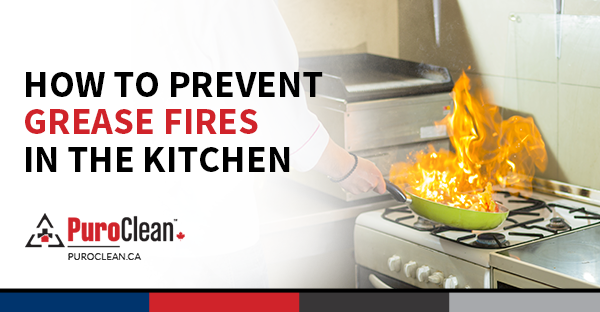The PuroClean Blog
How to Prevent Grease Fires in the Kitchen
 Grease fires are some of the most common types of fires that occur in the kitchen. Leaving a pan on the fire for too long or leaving excess grease on the stovetop are some of the causes of grease fires. However, as long as the cooking equipment is supervised and used with caution, preventing grease fires is simple. Below are essential tips to prevent and handle grease fires in the kitchen:
Grease fires are some of the most common types of fires that occur in the kitchen. Leaving a pan on the fire for too long or leaving excess grease on the stovetop are some of the causes of grease fires. However, as long as the cooking equipment is supervised and used with caution, preventing grease fires is simple. Below are essential tips to prevent and handle grease fires in the kitchen:
- When heating oil for deep-fat frying or pan-frying, a responsible adult should stay in the kitchen at all times. Unattended cooking is the number one reason for kitchen fires.
- Before turning the heat on, the burner or stovetop must be cool. Also, any excess grease or oil spills should be removed from the drip pan and around the burner.
- The heat ratings of cooking oil should be checked with a thermometer. The ratings indicate the maximum temperature the oil can be cooked at before catching fire. The smoking point of most vegetable oils is around 230 degrees Celsius and around 190 degrees Celsius for animal oils.
- When cooking oil is close to burning point, it will emit smoke and will ruin the taste of the food. If this happens, the heat should be turned off and the pan should be carefully removed and the burner allowed to cool off.
- Grease must not be heated before dropping food into it. Otherwise, hot grease might splash out onto nearby objects, creating a fire hazard and causing injuries.
- Food must be put into hot oil with caution. Long utensils allow one to gently put food into hot grease without dropping it and causing splashes.
- A lid should be used to cover the pan to prevent hot oil from splattering. If the food must be stirred, the lid should be carefully removed and put back after stirring the food.
- Oil and food spills must be cleaned immediately after they occur. First, the stove must be turned off and then the food can be removed from the heat source. Oil spills should be removed only after the stove has cooled off.
- If grease catches fire, the pan or pot should not be moved. Instead, a metal lid should be put on top of the pan to shut off the oxygen supply to the fire.
- A small fire that is contained within a pan can be extinguished by pouring baking soda on the fire until it’s out. If controlling the fire does not feel safe, the house must be evacuated immediately and the fire department must be contacted.
- A Type K fire extinguisher should be used to put out grease flames that are out of control.
- Water should never be used to put out a grease fire! Pouring water may cause grease to splash and spread the fire.
More tips to prevent stovetop and oven fires area available here and more general kitchen fire safety guidelines can be found in this article. The PuroClean team stands ready to provide professional restoration services to any property affected by fire, water or mould damage.
March 17, 2017



